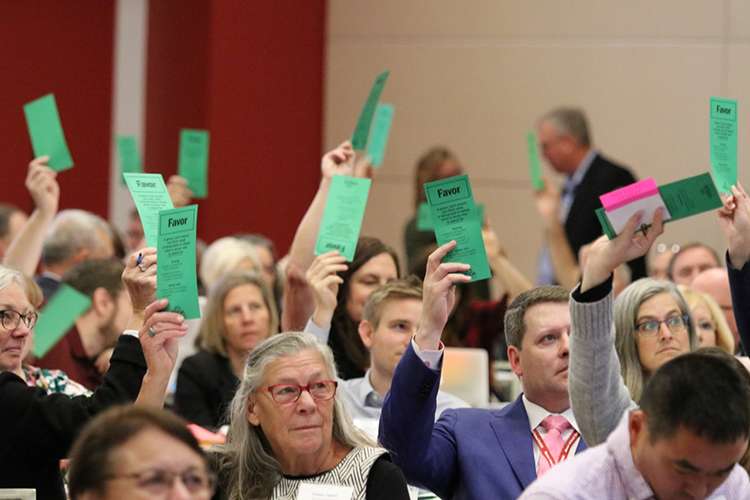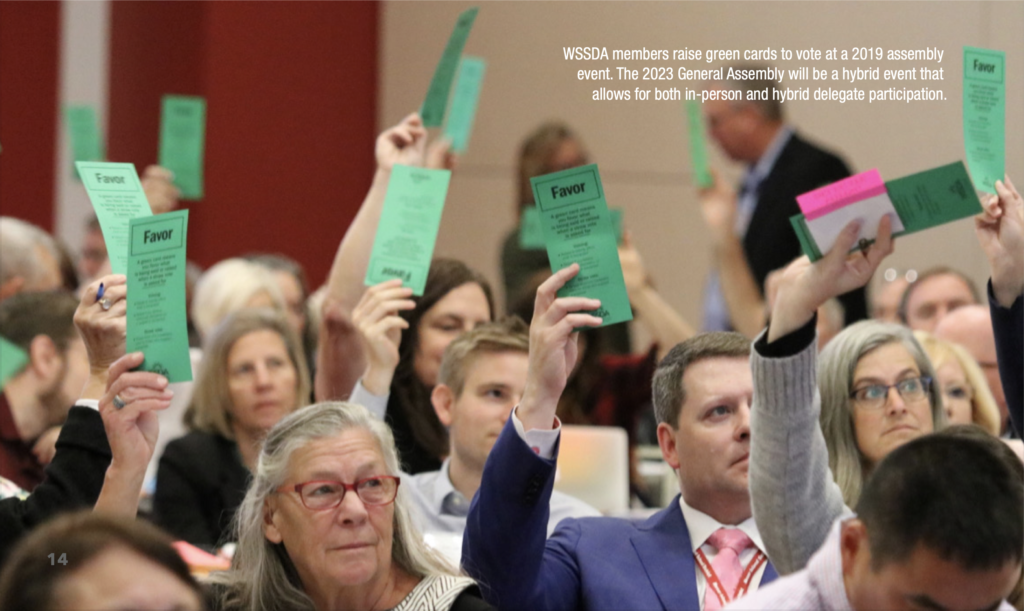How school boards direct WSSDA’s advocacy

What do you get when you gather 1,477 school board directors from around Washington state? Answer: 1,477 different perspectives. So how does WSSDA go from 1477 viewpoints down to a single advocacy platform? It’s simple: democracy.
Basically, it’s a year-round process with three phases: reflection, discussion, and voting. School boards are encouraged to reflect on WSSDA’s positions throughout the year. In the spring, they discuss any updates or changes a board might want and then propose them through an online process. All proposals will be debated and voted on at General Assembly in the fall.
“I can’t stress enough how much we need every school board to participate,” said WSSDA board member Katherine Humphrey of Boistfort School District. “If you’re a small district, like mine, please don’t think your vote doesn’t count. It’s important we all engage with the process to represent our schools and communities. WSSDA needs the input of each of us to best represent every corner of our diverse state.”
WSSDA has over 200 positions that make up its platform. The platform directs WSSDA’s support or opposition to education legislation as it moves through government at the state and federal levels. That’s why it’s important that all boards participate in the revision process each year.
When position proposals are submitted in the spring, they’re sorted into two categories: permanent and legislative. Permanent positions represent WSSDA’s beliefs and values and indicate WSSDA’s stance on issues of widespread concern for its membership. Those proposals go to WSSDA’s Resolutions Committee. Legislative positions are calls to action for the Legislature, so those proposals go to WSSDA’s Legislative Committee.

“One of the most important things to remember about the Legislative Committee is that we don’t show up representing our own personal point of view or the view of our district,” said Legislative Committee Chair Rebecca Stillings. “That is one of the key things that we need to remember as we go about doing the work of 295 school districts across the state. We take all the proposals and carry them through debate and discussion, and ultimately decide whether we believe as a committee that these positions are representative of the state as a whole and what we, as an association, want for public education in the state of Washington.” The committee then makes a recommendation of “pass” or “do not pass” for the General Assembly, where boards will vote according to their preference.
“Some of these legislative positions can make a huge difference in the success of our students,” said Legislative Committee member Marisa Peloquin of University Place School District. “For example, I come from a military background, and one of WSSDA’s positions revolves around graduation pathways. We’ve got a lot of students who are sons or daughters of military service members that have moved from other states and still want to have a viable pathway to graduation. And so, part of that legislative position was making sure that students had the right pathway, that barriers were reduced, and that they could still transfer from, say, Fort Bragg, North Carolina, to Joint Base Lewis-McChord and still be able to graduate with the work that they had already done.”
While the Legislative Committee focuses on legislative action, the Resolutions Committee shepherds positions that represent core values, such as the idea that students deserve a voice on school boards. “It’s important to us as a committee that we’re trying to represent all of Washington in what we do, that our positions are unbiased, they’re nonpolitical,” said Resolutions Committee Chair Trey Ising. “They’ll stand the test of time regardless of what’s going on in the world.”
School boards can consider proposals for the WSSDA platform before spring. Directors are encouraged to read and review the platform year-round. Especially while using it during a legislative session, they should jot down improvements they might hope to see. Then in springtime, if a board agrees upon some improvements, they can propose them between April 17 through May 12 of this year.
Channeling WSSDA’s multitude of perspectives into a single platform is an opportunity to engage in friendly debate, disagree with grace, and find common ground. In the words of Resolutions Committee Vice Chair Melissa Beard, “We might disagree on certain solutions to problems, but we all usually agree on what the goal is, and it’s to make sure students can succeed.”
This article was originally featured in the Spring 2023 issue of Direct. Visit wssda.org/direct to see all the latest issues.
